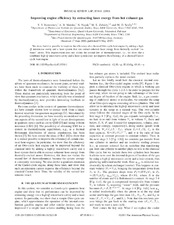| dc.creator | Rostovtsev, Y. V. | |
| dc.creator | Matsko, A. B. | |
| dc.creator | Nayak, N. | |
| dc.creator | Zubairy, M. Suhail | |
| dc.creator | Scully, Marlan O. | |
| dc.date.accessioned | 2011-09-08T21:36:07Z | |
| dc.date.available | 2011-09-08T21:36:07Z | |
| dc.date.issued | 2003 | |
| dc.identifier.citation | Y. V. Rostovtsev, A. B. Matsko, N. Nayak, M. Suhail Zubairy and Marlan O. Scully. Phys.Rev.A 67 053811 2003. "Copyright (2003) by the American Physical Society." | en |
| dc.identifier.uri | http://dx.doi.org/10.1103/PhysRevA.67.053811 | |
| dc.identifier.uri | https://hdl.handle.net/1969.1/126565 | |
| dc.description | Journals published by the American Physical Society can be found at http://publish.aps.org/ | en |
| dc.description.abstract | We show that it is possible to improve the efficiency of a classical Otto-cycle heat engine by adding a high-Q microwave cavity and a laser system that can extract coherent laser energy from thermally excited "exhaust" atoms. This improvement does not violate the second law of thermodynamics, i.e., we show that a combined high-Q microwave cavity and a laser system does not improve the efficiency of a classical Carnot-cycle heat engine. | en |
| dc.language.iso | en | |
| dc.publisher | American Physical Society | |
| dc.subject | SINGLE THERMAL BATH | en |
| dc.subject | INVERSION | en |
| dc.subject | AMPLIFICATION | en |
| dc.subject | WORK | en |
| dc.subject | Optics | en |
| dc.subject | Physics | en |
| dc.title | Improving engine efficiency by extracting laser energy from hot exhaust gas RID A-1272-2007 | en |
| dc.type | Article | en |
| local.department | Physics and Astronomy | en |


